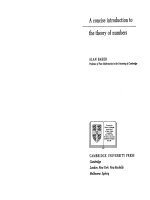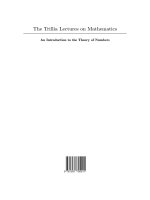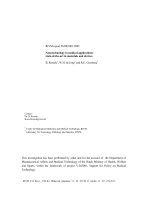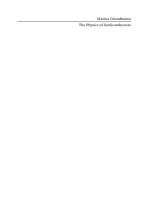The joy of numbers shakuntala devi
Bạn đang xem bản rút gọn của tài liệu. Xem và tải ngay bản đầy đủ của tài liệu tại đây (2.17 MB, 157 trang )
SHAKUNTALA
nEVI
Figuring
THE
JOY
OF
NUMBERS
HARPER
& ROW, PUBLISHERS
New
York,
Hagerstown, San Francisco,
London
FIGURING
THE
JOY
OF
NUMBERS.
Copyright © 1977 by Shakuntala Devi. All rights
reserved. Printed in the United States
of
America. No part
of
this book may
be
used
or
reproduced
in
any manner whatsoever without written permission except
in
the case
of
brief quotations embodied
in
critical articles and reviews. For information
addre&s
Harper & Row, Publishers, Inc.,
10
East 53rd Street, New York,
N.
Y.
10022.
FIRST
U
SEDITION
ISBN 0-06-011069-4
LIBRARY
OF
CONGRESS
CATALOG
CARD
NUMBER
78-4731
78 79 80
81
82
10
9 8 7 6 5 4 3 2 I
CONTENTS
Introduction
9
1 Some Terms Defined
11
2
The
Digits
15
3
Multiplication
31
4
Addition
48
5
Division
52
6 Subtraction
60
7
GCMand
LCM
62
8 Squares and Square Roots
68
9
Cubes and Cube Roots
77
10
Percentages, Discounts and Interest
87
11
Decimals
94
12
Fractions
99
13
The
Calendar
104
14
Some Special Numbers
112
15
Tricks and Puzzles
131
Conclusion
157
possessed
of
moving and non-moving beings, can-
not exist
as
apart from the 'Ganita' (calculation)
Mahavira
(AD
850)
At three I
fell
in love with numbers.
It
was
sheer ecstasy for me
to do sums and get the right answers. Numbers were toys with
which I could play.
In
them I found emotional security; two
plus two
always
made, and would always make, four - no matter
how the world changed.
My interest grew with age. I took immense delight in working
out huge problems mentally - sometimes even faster than elec-
tronic calculating machines and computers.
I travelled round the world giving demonstrations
of
my
talents.
In
every country I performed for students, professors,
teachers, bankers, accountants, and even laymen who knew very
little, or nothing at all, about mathematics. These performances
were a great success and everywhere I
was
offered encouragement
and appreciation.
All
along I had cherished a desire to show those who think
mathematics boring and dull just
how
beautiful it can be. This
book
is
what took shape.
It
is written in the knowledge that there is a range and rich-
ness to numbers: they can come alive, cease to be symbols
written on a blackboard, and lead the reader into a world
of
intellectual adventure where calculations are thrilling, not
tedious.
To
understand the methods I describe you need nothing more
than a basic knowledge
of
arithmetic. There are no formulae,
technical terms, algebra, geometry, or logarithms here -
if
you
9
10
Introduction
can carry out the basic functions
of
adding, subtracting, multi-
plying, and dividing you can follow
all
of
it. At first glance some
of
the steps may seem complicated but
if
you take them slowly
you should be able to acquire the skill to solve a wide variety
of
problems without mistakes - and to do this mentally, or with a
minimum use
of
pencil and paper. But above
all
I would wish
this book to
give
people an appreciation
of
the enchantment
of
numbers.
1
SOME
TERMS
DEFINED
In
this book
we
are not going to be concerned with
10'5clrithms
or the Calculus, not even with algebra, except in the most
elementary
way.
So
those who found that these aspects
of
mathe-
matics
gave
them a life-long
tf~ror
of
the whole subject can relax.
We are going to be dealing with ordinary numbers which should
hold
no
terrors for anyone.
We will be encountering some mathematical terms and con-
ventions, but most
of
them are in everyday use. I shall be using
them because they are the simplest and clearest means
of
stating
mathematical problems or explanations. But they do all have
precise meanings and, even
if
you are confident that you under-
stand them, it would be
as
well to read this short chapter so
that
we
can both
be
sure
we
are talking about the same
things.
A
Digit
is
an individual numeral; there are ten
of
them:
1,2,3,
4,
5,
6,
7,
8, 9, and
O.
A
Fraction
in everyday language means a part
of
a whole.
In
mathematics it normally has a slightly more precise meaning -
a part
of
a whole expressed by putting one figure over another and
dividing them by a line,
as
in ! or
1.
The
figure on top is called
II
12
Figuring
the
numerator
(it tells you
how
many parts you've got) and the
one below is called the
denominator
(it tells you what proportion
of
a whole each part is). They can also be written
as
1/2
or 1/4
where the oblique stroke divides numerator and denominator.
Decimals
are simply a different
way
of
expressing the same
thing. Instead
of
the denominator being variable,
as
in fractions,
in decimals it
is
always ten, or rather tens, because the system
can be extended infinitely to hundredths, thousandths, ten-
thousandths, etc
of
a whole.
Thus
·1
is
the same
as
1/10 and
·01
is the same
as
1/100 and
·11
is
the same
as
11/100.
Percentage
is
yet another
way
of
expressing the same thing.
This time the denominator
is
always
100
-
so
4%
is
the same
as
·04 or 4/100. Percentages can be combined with decimals
or
fractions
if
it is necessary to express parts smaller than one-
hundredth. Thus, one-five-hundredth can be expressed either
as
,2%
or
as
!%.
Multiplication
is
of
course to multiply one number by another.
The
number that
is
multiplied
is
called the
multiplicand,
the
number by which it
is
to be multiplied
is
called the
multiplier
and
the result
is
called the
product
of
the two numbers. Thus 2
(multiplier)
X 4 (multiplicand) = 8 (product). A
multiple
of
a
number
is
simply a number which
is
made up by multiplying the
original number a given number of times. Thus,
2,
4,
6,
8,
etc
are
all
multiples
of
2.
Division
is the reverse
of
multiplication, the division of
one
number by another.
The
number to be divided
is
called the
dividend and the number by which it
is
to
be
divided
is
called
the
divisor.
If
the divisor does not
go
into the dividend an exact
number
of
times, then the figure left over
is
the
remainder.
For
Some
Terms
Defined
13
example 9 (dividend)
-;-
2 (divisor) = 4 with 1 left over
as
a
remainder.
If
there
is
no remainder then the result and the
divisor are
factors
of the dividend. For instance, 2 and 3 are
factors of
6.
The factors of a number can
also
be
broken down
into their smallest parts; thus the factors
of
12
are
2,
2 and
3,
or
as
it
is
usually put, 2 X 2 X
3.
Addition and
subtraction
are
so
basic that
all
we
need note
is
that in addition the result
is
known
as
the
sum
of the numbers
that
have
been added up; and in subtraction the result
is
known
as
the
remainder,
ie,
what
is
left over after one number has been
taken from another.
Roots and powers.
If
a number
is
multiplied
by
itself, the pro-
duct
is
the
square
of
that number - the square
of
2
is
4 and two-
squared
is
written
22.
If
the square
is
again multiplied by the
original number,
ie
22
X
2,
then the result
is
the
cube
of
the
number, which
is
written
23.
The process can
of
course be
continued
ad
infinitum
- and
is
called raising a number to its
fourth or fifth or 6785th
power.
The
root
of
a number is the
original number which
was
squared or cubed or raised to the
power
of
something in order to produce that number. For
example the square root of 9
is
3 because 3 X 3 = 9.
The
cube
root
of
27
is
also
3 because 3 X 9 =
27,
and the fourth root
of
81
is
also
3 because 3 X
27
=
81.
The
way
this
is
written
is
v'9
in the
case
of a square root and sv'27 or 'v'81 in the
case
of
cube, fourth or further roots.
The
sixth root
of
64
is
2; so 2 can
be
written mathematically
as
6v'64, just
as
64
can be written
28.
We
will
be
encountering a
few
more technical terms
as
we
go
along, but these are the basic ones which you will need right
through the
book.
It's important that, however elementary they
seem, you fully grasp what they mean.
As
I said above they do
14
Figuring
have precise meanings - for example the difference between the
product
of
4 and 4
(4
x 4 =
16)
and the sum
of
4 and 4
(4
+ 4 =
8)
is
obviously very important; so it
is
worth just re-
checking to make sure that they are
all
absolutely clear in your
head before going any further.
2
THE
DIGITS
The ten digits,
1,
2,
3,
4,
5,6,
7,
8,9
and 0, are the 'alphabet'
of
arithmetic. Arranged according to the conventions
of
mathe-
matics and in conjunction with symbols for addition, subtraction,
etc, the digits
make
up 'sentences' - problems, equations and their
solutions. Just
as
the letters
of
the alphabet have their own pecu-
liarities and rules
(i
before e except after c, etc),
so
the digits
each have a particular character in arithmetic. Some
of
their
oddities can be put to good use, others are merely interesting or
amusing for their own sake.
In
this chapter
we
are going to look at the digits individually
and especially at their multiplication tables.
The
older
of
us, at
least,
will
remember sitting in school learning by heart 'one eight
is
eight,
two
eights are sixteen, three eights are twenty-four,
'.
I hope to show you that even in these rather dreary tables there
is interest and surprise. For,
as
well
as
regular steps which
we
had to learn by rote, each table contains intriguing 'secret steps'
which vary with the different digits.
The
discovery
of
these
secret steps depends on a technique which
is
going to crop up
throughout this book, and one which I would like to explain at the
outset.
It
very simply consists
of
adding together the digits in
any number made up
of
two or more digits. For example, with
the number
232
the sum
of
the digits
is
2 + 3 + 2 =
7.
If
the
IS
16
Figuring
sum
of
the digits comes to a two-digit number (for example
456,
4 + 5 + 6 =
15)
then normally
you
repeat the
process
(1
+ 5 =
6).
The secret steps in the multiplication tables are made
by
applying this technique to the products given by the straight
steps. For instance in the 4-times table 3
X 4 =
12
(straight
step); 1
+ 2 = 3 (secret step); or in the 9-times table
11
X 9 =
99; 9 + 9 =
18,
1 + 8 =
9.
So,
with that technique in mind, let us
look
at the digits
one
at a time.
NUMBER
1
The first thing about the number 1
is
of course
th~!
whatever
figure
you
multiply it by, or divide by it, remains unchanged.
The first nine places in the I-times table therefore have
no
secret steps, or at least they are the
same
as
the normal ones, but
after that it becomes more interesting:
10
X 1 =
10
11xl=l1
12
X 1 =
12
13xl=13
14
X 1 =
14
15
X 1 =
15
16
X 1 =
16
1+0=1
1+1=2
1+2=3
1+3=4
1+4=5
1+5=6
1+6=7
and
so
on.
No matter
how
far
you
go
you
will
find
that the
secret steps
always
give
you
the digits from 1
to
9 repeating
themselves in sequence. For example:
Straight
steps
154
X 1 =
154
155
X 1 =
155
156
X 1 =
156
157
X 1 =
157
158
X 1 =
158
159
X 1 =
159
160
X 1 =
160
161
X 1 =
161
The
Digits
17
Secret
steps
1 + 5 + 4 =
10,
1 + 0 = 1
1 + 5 + 5 =
11,
1 + 1 = 2
1 + 5 + 6 =
12,
1 + 2 = 3
1 + 5 + 7 =
l3, 1 + 3 = 4
1 + 5 + 8 =
14,
1 + 4 = 5
1 + 5 + 9
=
15,
1 + 5 = 6
1+6+0
=7
1+6+1
=8
In
this case it is fairly obvious why the secret steps work,
but
none the less it is a curiosity
that
may not have occurred to you
before.
Another curiosity about the
number
1
is
its talent for creating
palindromes (numbers that read the same backwards as forwards):
1 X 1 1
11x11
121
III
X
111
12321
Illl
X
Illl
1234321
lllll
X
Illll
123454321
Illlll
X
llllll
12345654321
1111111
X
1111111
1234567654321
11111111
X
11111111
123456787654321
111111111
X
111111111
=
12345678987654321
At that point it stops,
but
the same thing works briefly with the
number
11:
II
X
II
=
121
11
X
II
X
11
= l331
II
X II X
II
X
11
=
14641
18
Figuring
Finally the fact that 1 is,
so
to speak, immune
to
multiplication
means that whatever power you raise it to it remains unchanged:
1584788
=
1.
By
the same token, 8y l =
1.
NUMBER
2
The
number 2 has one very obvious characteristic, to multiply
any number by 2 is the same
as
adding it to itself.
As
for the
multiplication table and its secret steps:
2xl=
2 2
2x2=
4 4
2x3=
6
6
2x4=
8
8
2x5=10
1+0=1
2 X 6 =
12
1+2=3
2 X 7 =
14
1+4=5
2 X 8 =
16
1+6=7
2 X 9 =
18
1+8=9
2 X
10
=
20
2+0=2
2 X
11
=
22
2+2=4
2 X
12
=
24
2+4=6
2x13=26
2+6=8
2 X
14
=
28
2 + 8 =
1[0]
2 X
15
=
30
3+0=3
2 X
16
=
32
3+2=5
2 X
17
=
34
3+4=7
2 X
18
=
36
3+6=9
And
so
on.
The
Digits
19
As
you
can check
for
yourself, the secret steps
go
on working
ad
infinitum,
always
giving you the same sequence
of
the four
even digits followed by the
five
odd ones.
There
is
an amusing little party trick that can be played with
the number
2.
The problem
is
to express all ten digits, in each
case using the number 2
five
times and no other number. You
are allowed to use the symbols
for
addition, subtraction, multi-
plication and division and the conventional method
of
writing
fractions. Here
is
how it
is
done:
2 + 2 - 2 -
2/2
= 1
2+2+2-2-2=2
2 + 2 - 2 +
2/2
= 3
2x2x2-2-2=4
2 + 2 + 2 -
2/2
= 5
2+2+2+2-2=6
22-;-2-2-2=7
2x2x2+2-2=8
2 X 2 X 2 +
2/2
= 9
2 -
2/2
-
2/2
= 0
Finally, here
is
another oddity associated with 2:
123456789
+
123456789
+
987654321
+
987654321
+2
2222222222
20
Figuring
NUMBER
3
The
number three has two distinctions. First
of
all
it is the first
triangle number - that
is
a number the units
of
which can
be
laid out to form a triangle, like this 000' Triangle numbers have
importance and peculiarities
of
their own which
we
shall
encounter later on.
Three
is
also a prime number, a number that cannot be evenly
divided except by itself and by
1.
1 and 2 are
of
course prime
numbers, the next after 3 is
5,
then
7,11,13,17,19
and 23; after
that they gradually become increasingly rare. There are a couple
of
strange things about the first
few
prime numbers, for
example:
153
=
IB
+
53
+ 3
3
And 3 and 5 can also both be expressed as the difference between
two squares:
3
=22
-
12
5 = 3
2
-
22
The
secret steps in the 3-times table are very simple:
Straight
steps
3 X 1 = 3
3 X
2=
6
3
X 3 = 9
3
X 4 =
12
3 X 5 =
15
3 X 6 =
18
Secret
steps
3
6
9
1+2=3
1+5=6
1+8=9
The
Digits
21
3 x 7 =
21
3 x 8 =
24
3 x 9 =
27
3 x
10
=
30
3 x
11
=
33
3 x
12
=
36
2+1=3
2+4=6
2+7=9
3+0=3
3+3=6
3+6=9
Again the pattern
of
the secret steps recurs whatever stage you
carry the table up to - try it and check for yourself.
NUMBER
4
With number 4 the secret steps in the multiplication tables
become a little more intricate:
Straight
steps
Secret
steps
4
xl
= 4
4
4x2=
8
8
4
X 3 =
12
1+2=
3
4
X 4 =
16
1+6=7
4 X 5
=20
2+0=
2
4
X 6 =
24
2+4=6
4 X 7 =
28
2 + 8 =
10
1+0=
1
4
X 8 =
32
3+2=5
4 X 9 =
36
3+6=
9
4xlO=40
4+0=4
4x11=44
4+4=
8
4
X
12
=
48
4 + 8 =
12
1+2=3
4 X
13
=
52
5+2=
7
4
X
14
=
56
5+6=11
1+1=2
4 X
15
=
60
6+0=
6
4
X
16
=
64
6 + 4 =
10
1+0=1
22
Figuring
At first the sums
of
the digits look like a jumble
of
figures, but
choose at random any sequence
of
numbers and multiply them
by 4 and you will see the pattern emerge
of
two interlinked
columns
of
digits in descending order. For example:
2160
X 4 =
8640
8+6+4+0=18
1+8=
9
2161
X 4 =
8644
8+6+4+4=22
2+2=4
2162
X 4=8648
8+6+4+8=26
2+6=
8
2163
X 4=8652
8+6+5+2=21
2+1=3
2164
X 4=8656
8+6+5+6=25
2+5=
7
2165
X 4 =
8660
8+6+6+0=20
2+0=2
2166
X 4 =
8664
8+6+6+4=24
2+4=
6
2167
X 4=8668
8+6+6+8=28
2+8=10
1+0=1
2168
X 4=8672
8+6+7+2=23
2+3=
5
NUMBER
5
Perhaps the most important thing about 5 is that it is half
of
10;
as
we
will see, this fact is a
key
to many shortcuts in calculation.
In
the meantime the secret steps in the 5-times table are very
similar to those in the 4-times, the sequences simply
go
upwards
instead
of
downwards:
Straight
steps
Secret
steps
5xl=
5
5
5x2=10
1+0=1
5 X 3 =
15
1+5=
6
5 X 4 =
20
2+0=2
5 X 5 =
25
2+5=
7
5
X 6 =
30
3+0=3
5 X 7 =
35
3+5=
8
The Digits
23
5x8=40
4+0=4
5 X 9 =
45
4+5=
9
5 x
10
=
50
5+0=5
5 X
11
=
55
5 + 5 =
10
1+0=
1
5
X
12
=
60
6+0=6
5 X
13
=
65
6+5=11
1+1=
2
5 X
14
=
70
7+0=7
5 X
15
=
75
7 + 5 =
12
1+2=
3
5 X
16
=
80
8+0=8
5 X
17
=
85
8+5=13
1+3=
4
5
X
18
=
90
9+0=9
5 X
19
=
95
9 + 5 =
14
1+4=
5
And
so
on.
NUMBER
6
This
is
the
second
triangle number;
and
the
first
perfect number -
a
perfect
number
is
one
which
is
equal
to
the
sum
of
all
its
divisors.
Thus, 1 + 2 + 3 =
6.
The secret steps in the 6-times table
are
very
similar
to
those
in the 3-times,
only
the order
is
slightly
different.
Straight
steps
Secret
steps
6
xl
= 6
6 X 2 =
12
6 X 3 =
18
6 X 4 =
24
6 X 5 =
30
6 X 6 =
36
6 X 7 =
42
6 X 8 =
48
4 + 8 =
12
6
1+2=3
1+8=9
2+4=6
3+0=3
3+6=9
4+2=6
1+2=3
24
Figuring
6 X 9 =
54
6 X
10=60
6 X
11
=
66
6 + 6 =
12
6 X
12
=
72
And
so
on.
NUMBER
7
5+4=9
6+0=6
1+2=3
7+2=9
This
is
the
next
prime
number
after
5.
The
secret
steps
in
the
7-times
table
almost
duplicate
those
in
the
2-times,
except
that
they
go
up
instead
of
down
at
each
step.
Straight
steps
Secret
steps
7xl=
7 7
7x2=
14
1+4=5
7x3=
21
2+1=3
7x4=
28
2+8=10
1+0=1
7x5=
35
3+5=8
7x6=
42
4+2=6
7x7=
49
4+9=13
1+3=4
7x8=
56
5+6=11
1+1=2
7x9=
63
6+3=9
7 X
10=
70
7+0=7
7
xlI
=
77
7 + 7 =
14
1+4=5
7 X
12
=
84
8 + 4 =
12
1+2=3
7 X
13
=
91
9+1=10
1+0=1
7 X
14=
98
9 + 8 =
17
1+7=8
7 X
15
=
105
1+0+5=6
7 X
16
=
112
1+1+2=4
7 X
17
=
119
1+1+9=11
1+1=2
7 X
18
=
126
1+2+6=9
7 x
19
=
133
7 x
20
=
140
And so on.
The
Digits
2S
1+3+3=7
1+4+0=5
There
is
a curious relationship between 7 and the number
142857.
Watch:
7x2
=7x2
=
14
7 x
22
= 7 x 4
-
28
7 x 2
3
= 7 x 8
56
7 x
2'
= 7 x
16
-
112
7 x 2
5
= 7 x
32
-
224
7 x 2
8
= 7 x
64
-
448
7 x
27
= 7 x
128
=
896
7 x 2
8
= 7 x
256
=
1792
7 x 2
9
= 7 x
512
=
3584
142857142857142(784)
However far you take the calculation, the sequence
142857
will
repeat itself, though the final digits on the right-hand side which
I have bracketed will be 'wrong' because they would be affected
by the next stage in the addition
if
you took the calculation on
further.
This number
142857
has itself some strange properties;
multiply it by any number between 1 and 6 and
see
what happens:
142857
x 1 =
142857
142857
x 2 =
285714
142857
x 3 =
428571
142857
x 4 =
571428
142857
x 5 =
714285
142857
x 6 =
857142




![the man of numbers - fibonacci's arithmetic revolution - k. devlin (walker, 2011) [ecv] ww](https://media.store123doc.com/images/document/14/y/ry/medium_rys1399113443.jpg)




